
The Apicomplexa are organisms of a large phylum of mainly parasitic alveolates. Most possess a unique form of organelle structure that comprises a type of (non-photosynthetic) plastid called an apicoplast—with an apical complex membrane. The organelle's apical shape is an adaptation that the apicomplexan applies in penetrating a host cell.

Cnidaria is a phylum under kingdom Animalia containing over 11,000 species of aquatic animals found both in fresh water and marine environments, including jellyfish, hydroids, sea anemones, corals and some of the smallest marine parasites. Their distinguishing features are a decentralized nervous system distributed throughout a gelatinous body and the presence of cnidocytes or cnidoblasts, specialized cells with ejectable flagella used mainly for envenomation and capturing prey. Their bodies consist of mesoglea, a non-living, jelly-like substance, sandwiched between two layers of epithelium that are mostly one cell thick. Cnidarians are also some of the only animals that can reproduce both sexually and asexually.
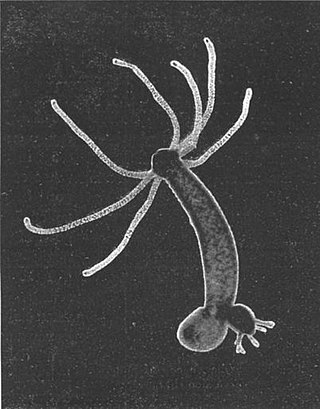
Hydra is a genus of small freshwater hydrozoans of the phylum Cnidaria. They are native to the temperate and tropical regions. The genus was named by Linnaeus in 1758 after the Hydra, which was the many-headed beast of myth defeated by Heracles, as when the animal has a part severed, it will regenerate much like the mythical hydra’s heads. Biologists are especially interested in Hydra because of their regenerative ability; they do not appear to die of old age, or to age at all.
In cell biology, an organelle is a specialized subunit, usually within a cell, that has a specific function. The name organelle comes from the idea that these structures are parts of cells, as organs are to the body, hence organelle, the suffix -elle being a diminutive. Organelles are either separately enclosed within their own lipid bilayers or are spatially distinct functional units without a surrounding lipid bilayer. Although most organelles are functional units within cells, some function units that extend outside of cells are often termed organelles, such as cilia, the flagellum and archaellum, and the trichocyst.
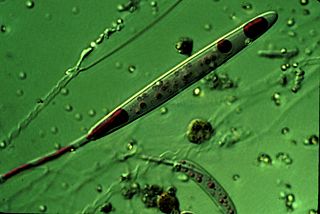
A cnidocyte is an explosive cell containing one large secretory organelle called a cnidocyst that can deliver a sting to other organisms. The presence of this cell defines the phylum Cnidaria. Cnidae are used to capture prey and as a defense against predators. A cnidocyte fires a structure that contains a toxin within the cnidocyst; this is responsible for the stings delivered by a cnidarian. Cnidocytes are single-use cells that need to be continuously replaced.
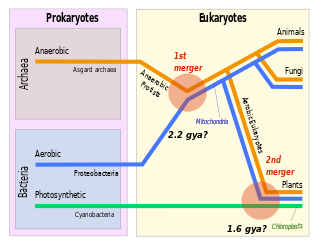
Symbiogenesis is the leading evolutionary theory of the origin of eukaryotic cells from prokaryotic organisms. The theory holds that mitochondria, plastids such as chloroplasts, and possibly other organelles of eukaryotic cells are descended from formerly free-living prokaryotes taken one inside the other in endosymbiosis. Mitochondria appear to be phylogenetically related to Rickettsiales bacteria, while chloroplasts are thought to be related to cyanobacteria.
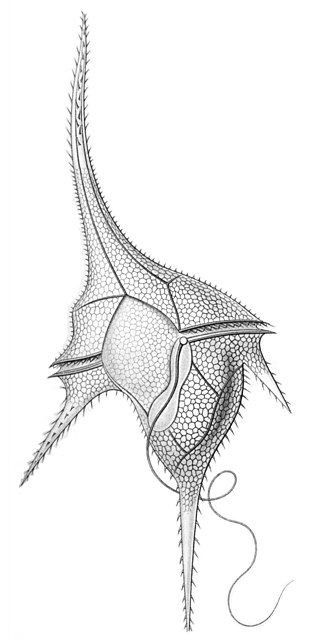
The dinoflagellates are a monophyletic group of single-celled eukaryotes constituting the phylum Dinoflagellata and are usually considered protists. Dinoflagellates are mostly marine plankton, but they also are common in freshwater habitats. Their populations vary with sea surface temperature, salinity, and depth. Many dinoflagellates are photosynthetic, but a large fraction of these are in fact mixotrophic, combining photosynthesis with ingestion of prey.

Symbiodinium is a genus of dinoflagellates that encompasses the largest and most prevalent group of endosymbiotic dinoflagellates known and have photosymbiotic relationships with many species. These unicellular microalgae commonly reside in the endoderm of tropical cnidarians such as corals, sea anemones, and jellyfish, where the products of their photosynthetic processing are exchanged in the host for inorganic molecules. They are also harbored by various species of demosponges, flatworms, mollusks such as the giant clams, foraminifera (soritids), and some ciliates. Generally, these dinoflagellates enter the host cell through phagocytosis, persist as intracellular symbionts, reproduce, and disperse to the environment. The exception is in most mollusks, where these symbionts are intercellular. Cnidarians that are associated with Symbiodinium occur mostly in warm oligotrophic (nutrient-poor), marine environments where they are often the dominant constituents of benthic communities. These dinoflagellates are therefore among the most abundant eukaryotic microbes found in coral reef ecosystems.

The vault or vault cytoplasmic ribonucleoprotein is a eukaryotic organelle whose function is not yet fully understood. Discovered and isolated by Nancy Kedersha and Leonard Rome in 1986, vaults are cytoplasmic organelles which, when negative-stained and viewed under an electron microscope, resemble the arches of a cathedral's vaulted ceiling, with 39-fold symmetry. They are present in many types of eukaryotic cells, and appear to be highly conserved among eukaryotes.

The Gymnodiniales are an order of dinoflagellates, of the class Dinophyceae. Members of the order are known as gymnodinioid or gymnodinoid. They are athecate, or lacking an armored exterior, and as a result are relatively difficult to study because specimens are easily damaged. Many species are part of the marine plankton and are of interest primarily due to being found in algal blooms. As a group the gymnodinioids have been described as "likely one of the least known groups of the open ocean phytoplankton."
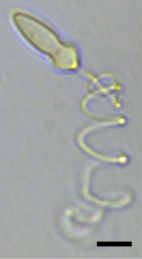
Polykrikos kofoidii is a species of phagotrophic marine pseudocolonial dinoflagellates that can capture and engulf other protist prey, including the toxic dinoflagellate, Alexandrium tamarense. P. kofoidii is of scientific interest due to its status as a predator of other dinoflagellates, a behavior that is significant in the control of algal blooms. It has a complex life cycle of both vegetative (asexual) and sexual reproduction complicated by its pseudocolonial structure.

An ocelloid is a subcellular structure found in the family Warnowiaceae (warnowiids), which are members of a group of unicellular organisms known as dinoflagellates. The ocelloid is analogous in structure and function to the eyes of multicellular organisms, which focus, process and detect light. The ocelloid is much more complex than the eyespot, a light-sensitive structure also found in unicellular organisms, and is in fact one of the most complex known subcellular structures. It has been described as a striking example of convergent evolution.

The Warnowiaceae are a family of athecate dinoflagellates. Members of the family are known as warnowiids. The family is best known for a light-sensitive subcellular structure known as the ocelloid, a highly complex arrangement of organelles with a structure directly analogous to the eyes of multicellular organisms. The ocelloid has been shown to be composed of multiple types of endosymbionts, namely mitochondria and at least one type of plastid.

A piston is a complex contractile organelle found in some dinoflagellates, namely the Erythropsidinium and Greuetodinium genera of the family Warnowiaceae. This group is also well known for possessing other unusually complex subcellular structures such as the ocelloid and nematocyst. Observations of Erythropsidinium samples reveal that the length of the piston is highly variable across specimens. The piston is known to be capable of repetitive and dramatic contractile motion; although its function is unknown, roles in locomotion, prey capture, and defense have been suggested.

The Polykrikaceae are a family of athecate dinoflagellates of the order Gymnodiniales. Members of the family are known as polykrikoids. The family contains two genera: Polykrikos and Pheopolykrikos.

Erythropsidinium is a genus of dinoflagellates of the family Warnowiaceae.

Polykrikos is one of the genera of family Polykrikaceae that includes athecate pseudocolony-forming dinoflagellates. Polykrikos are characterized by a sophisticated ballistic apparatus, named the nematocyst-taeniocyst complex, which allows species to prey on a variety of organisms. Polykrikos have been found to regulate algal blooms as they feed on toxic dinoflagellates. However, there is also some data available on Polykrikos being toxic to fish.

Polypodium is a genus of cnidarians that parasitizes in the eggs of sturgeon and similar fishes. It is one of the few metazoans (animals) that live inside the cells of other animals.

A symbiosome is a specialised compartment in a host cell that houses an endosymbiont in a symbiotic relationship.
Warnowia is a genus of athecate dinoflagellates, characterized by having a very sophisticated photoreceptor organelle called the ocelloid. This genus is dispersed worldwide but is scarce and difficult to find and nearly impossible to culture. As a result, the history and taxonomy of this genus are confusing at best, and many basic characteristics like its life cycle are still unknown. Still, Warnowia has drawn scientific interest as a unicellular organism with a fascinatingly complex photoreceptor system.















